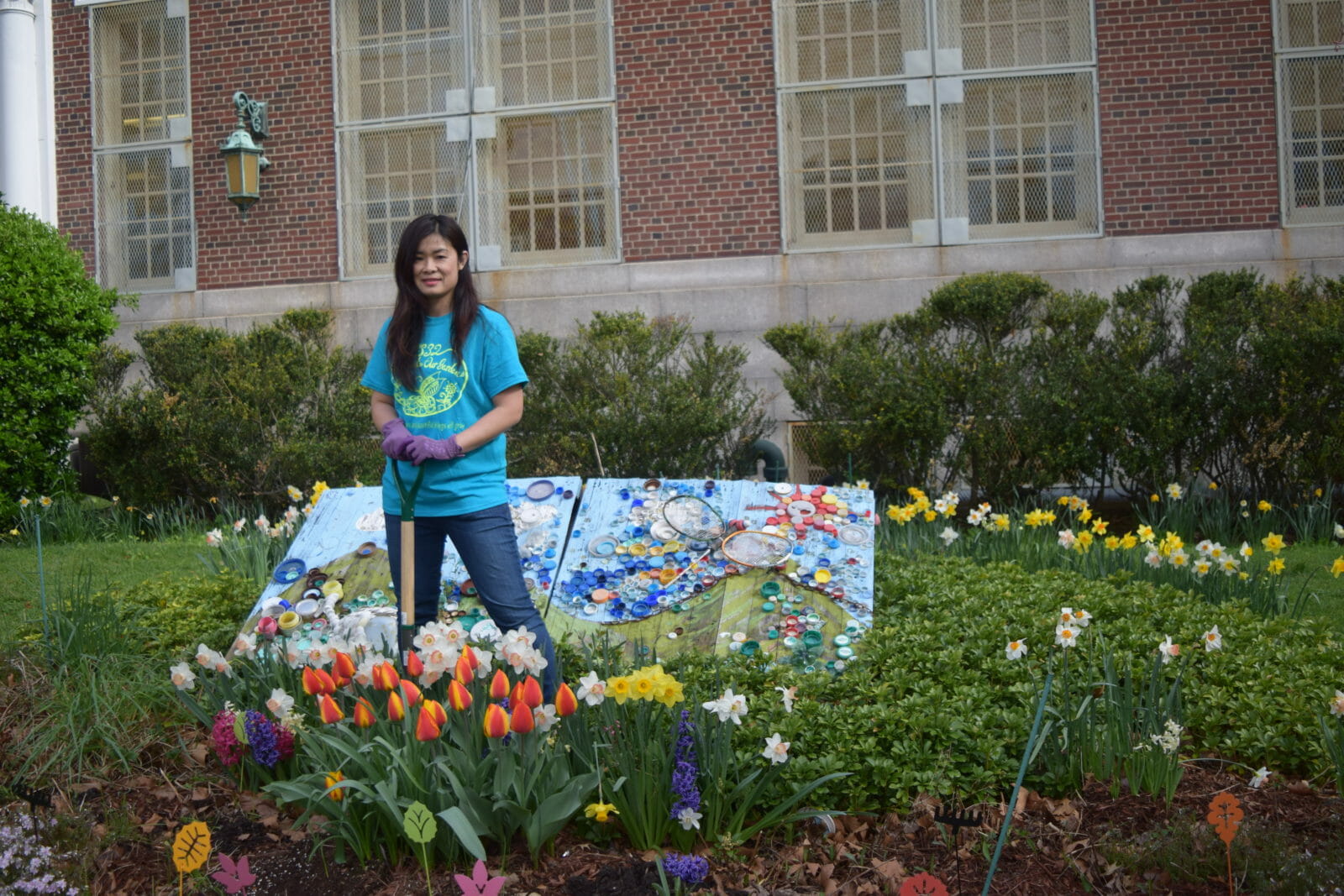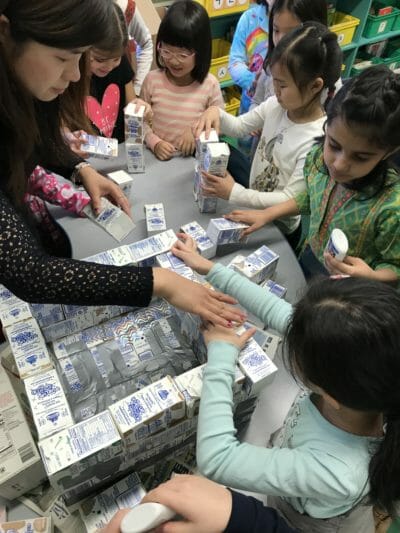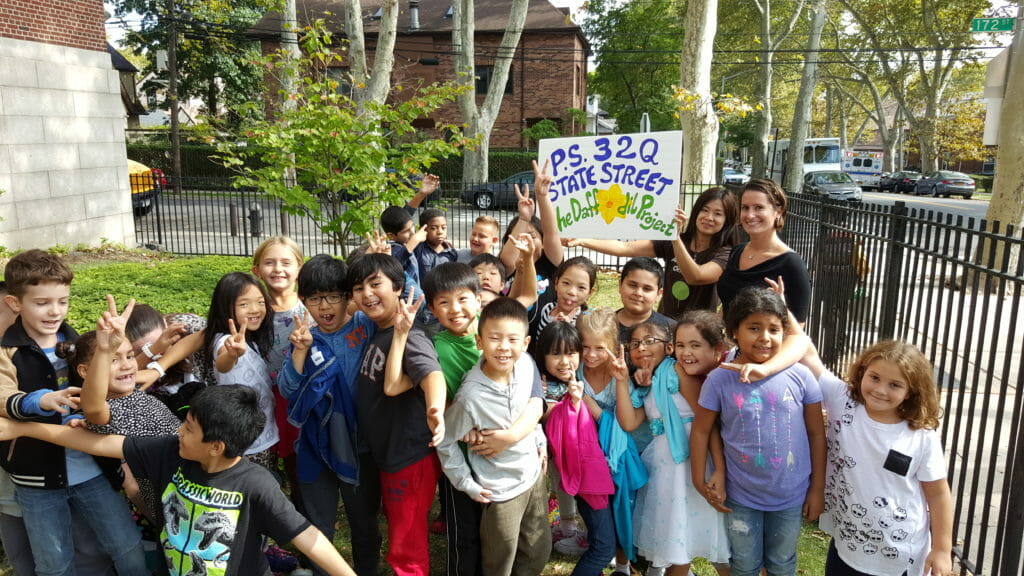New York Mom Takes the Learning Outdoors with School Gardening Program

With the prevalence of technology in our homes and classrooms, it’s getting harder and harder to see our children outside. According to the Washington Post, the average American child spends five to eight hours a day in front of a digital screen, and according to The Guardian, children today spend just over four hours a week playing outside, compared to 8.2 hours a week their parents spent outside when they were children.
Wing Kong of New York hopes to change that with her “Activate our Garden” program she started at her children’s school. With the help of teachers and other parents, Wing turned an empty space in the school yard into a garden, blooming with various flowers, plants, and even fruits and vegetables. Every week, she brings students out into the garden to teach them about gardening, the different parts of plants, and even healthy eating by getting the children to harvest and eat the vegetables that they helped grow.
She connects her lesson plans and projects to more than just gardening, however. By teaching her students how to reduce, reuse and recycle materials, she instills in them a sense of environmental stewardship and gets them thinking about larger concepts such as sustainability.
Wing is today’s Daily Point of Light award honoree and we spoke with her to learn more about her volunteerism with Activate our Garden.
Describe your volunteer role with “Activate Our Garden”
I started about five years ago, when my son was in first grade. Now he’s graduating this year. In New York City, there’s not a lot of space and our school is lucky in that there’s some space. I looked around and saw that no one really did anything with it. There were just evergreen spaces here and there. I saw the potential and how much we could utilize this into something more like a learning garden program that could help gather the community together and make this place a lot more welcoming. So that’s how I started. I wrote down an initial plan on what I would like to do and I designed it in a way so that it would be self-sustaining, so that we would be able to run this program through volunteering and fundraising.

The first project that I did was the “Daffodil Project.” It’s a school-wide project where every single child and staff plant a [daffodil] bulb. I linked that to the history of New York City, how the World Trade Center came down and how we want to remember what happened. We’re from New York City and we should all know about it no matter how old you are. We plant the daffodils in the fall and they come up in the spring. They come back every year so I wanted that to symbolize how we should remember what happened before every year. Also, the way a daffodil stands, the head is kind of titled a little bit, almost like it resembles a person mourning. However, it’s a rebirth every year to show we’re not afraid. We know what happened, we’re not afraid, and we still bloom and blossom every year.
The parents and principal really loved the program so I started to roll out more programs. The next year, the principal and assistant principal said, “Let’s add a gardening club,” so every week, there are children that can go out to help and maintain the garden. So I started co-teaching with another teacher this whole gardening program for children who sign up. Every year, there are more and more children who want to get in.
I also have this summer program where the family can come in with the child to help with the gardening. It’s a time where not just the parents come out or just the child, but the child and parents come out together so they can feel more connected with the school and community.
What inspires you to volunteer?
Nowadays, people are so busy. Busy from this, busy from that. There’s no time for them to pause and look around. Nature is such a special thing that a lot of people don’t take the time to appreciate. There’s so much to learn from it. A lot of parents say, “The dirt’s dirty. Don’t touch it.” So the gardening club is such a great opportunity for children to come in and say, “Hey Ms. Wing! I’m not afraid to get my hands dirty.” Last year, we submitted a project we had done and we were the citywide winner of two awards. So that gave us a boost and we got some extra funding for the program to expand
What’s been the most rewarding part of your work?
Seeing the reactions from them when I do experiments with them and seeing how much they love it. They say, “I want to be in gardening club again next year,” or they’ll tell others, “Gardening club is the coolest club!” We’ll have presentations and science fairs and when people ask them questions, they’re able to answer them. Sometimes I get notes or emails or in person, parents telling me what their child learned or how this changed their eating habits.
How are you achieving the impossible of getting children to eat their vegetables?
We plant the vegetables and fruits, harvest them and then we do taste tests. We do salad testings. That part is really fun. The kids who don’t normally eat vegetables, they actually ate them and wanted more which is a really cool feeling. We lined up different parts of the fruit. For example, a tomato that we planted, that is the fruit part. Then lettuce, what part of the plant is that? Okay, that’s the leaf part. Celery? That’s the stem part. We used olive oil as a dressing. What part of the plant is the olive? That’s actually the fruit and there’s a seed inside. All these things, they see and they learn.

What motivates you to keep volunteering and teaching these kids?
I feel that the next generation, if I expose them and teach them all these things, they will inspire other people. If I inspire them, they will learn something and inspire others or do something good out of it. Schools don’t necessarily have teachers to teach these specific themes or subjects. There is no funding for that. Since I started the program that already relates to it, and I’m able to create and roll out more programs, then why not?
Are there any future partnerships, programs, or events that you are excited about?
There’s an ongoing project right now called the Ocean Awareness Mural. It’s a really big mural that’s being placed inside our auditorium. The children collected all different kinds of plastic waste that we can reduce. For example, bottles and straws. So with these parts, we’re making an ocean awareness art mural that children in the school can see and realize that plastics are really taking over the world and think about what we can do to improve it.
Why do you think it’s important for others to give back?
It really doesn’t take much to help others, to inspire others. It feels so great to empower others and encourage others to do the same. Once you inspire one person, it spreads. Others will inspire others and that’s how everything spreads in a good way.
What do you want people to learn from your story?
When I first had this idea, people were like “You’re crazy. This is too big of a project.” And I said, “I wouldn’t suggest it if I couldn’t handle it.” There are many people who have ideas. When you have idea, start small and gain experience. Then once you get the hang of it, you can start to develop it and make it bigger and better.
Do you want to make a difference in your community like Wing? Click here for local volunteer opportunities.
